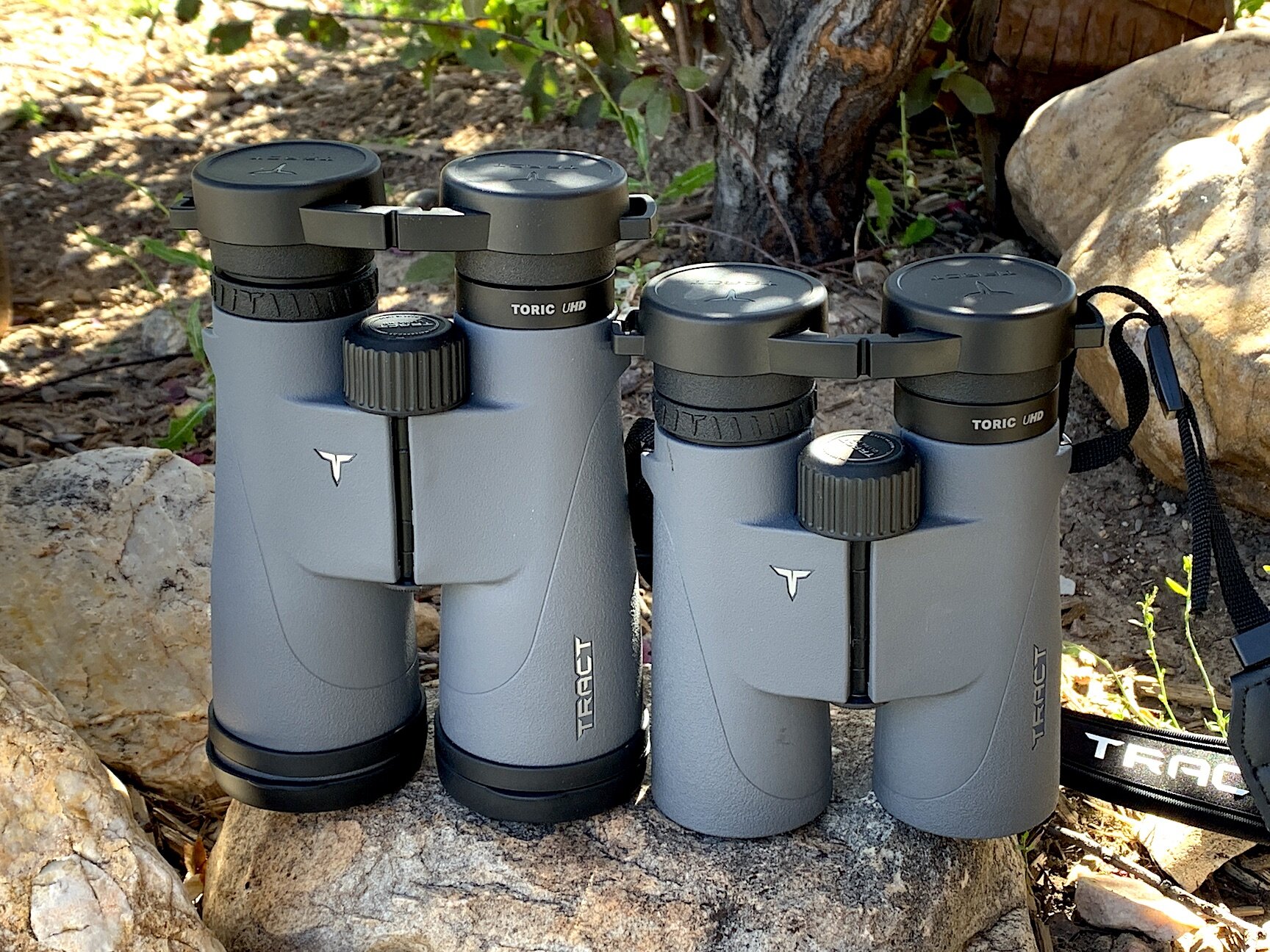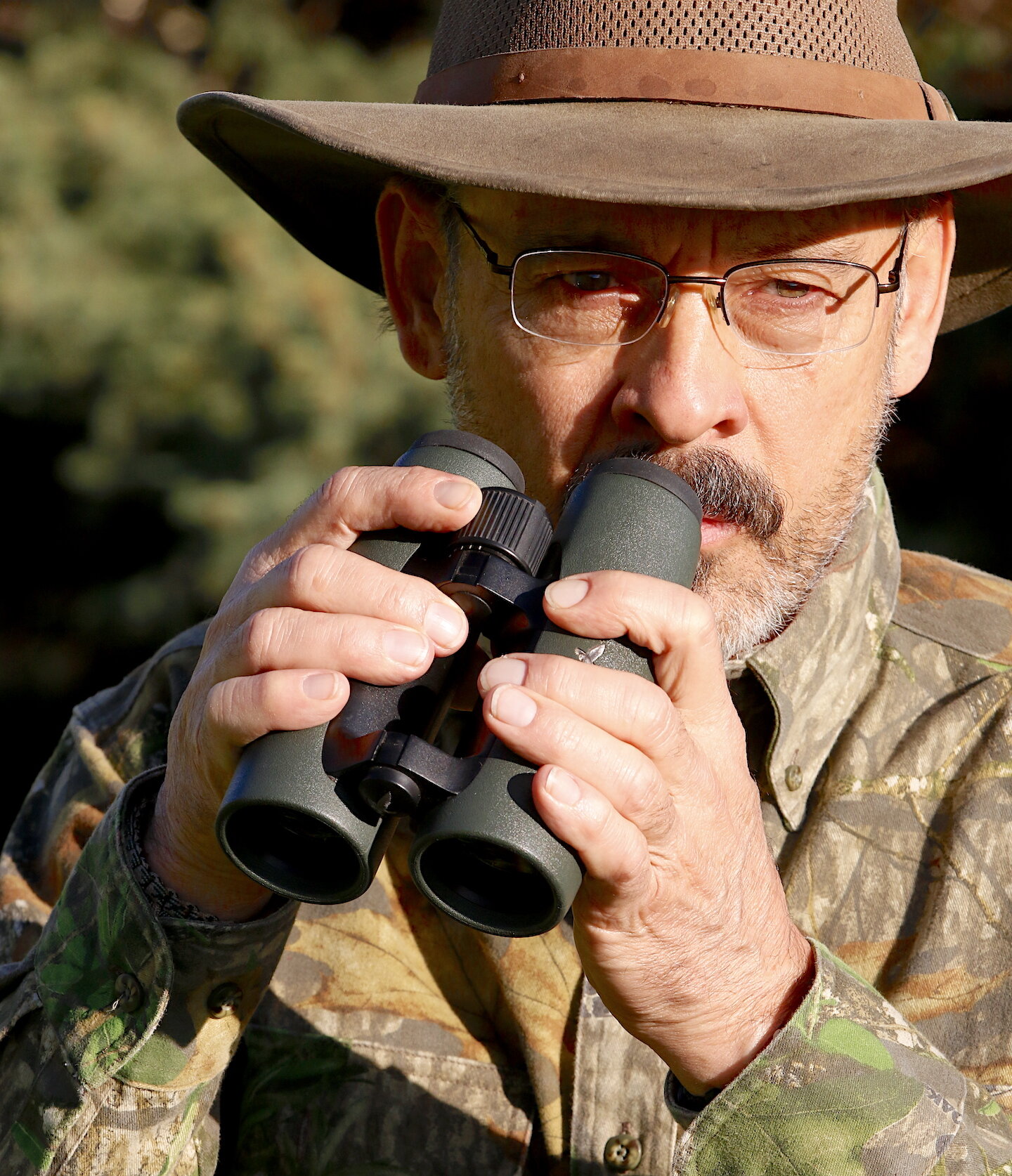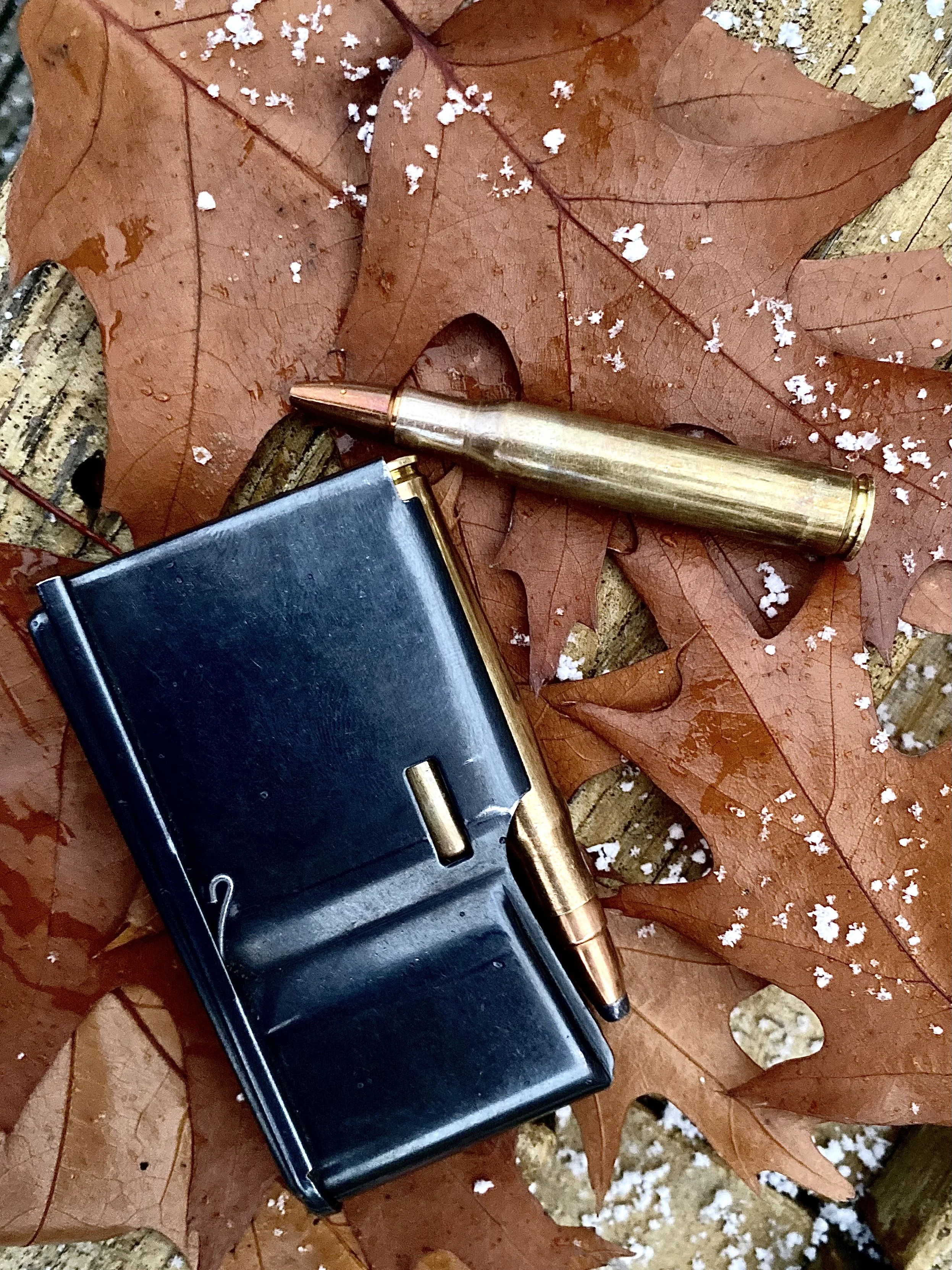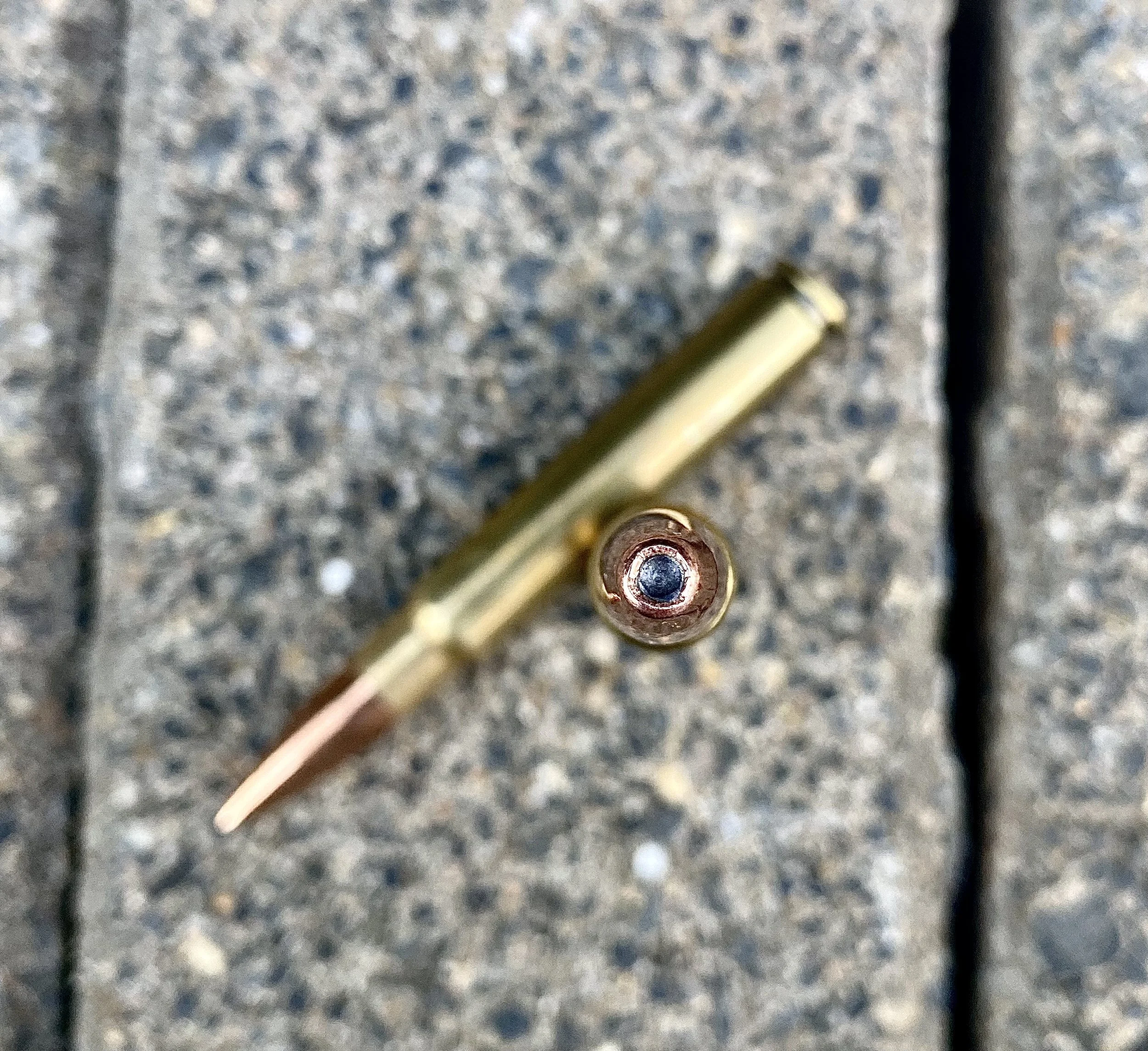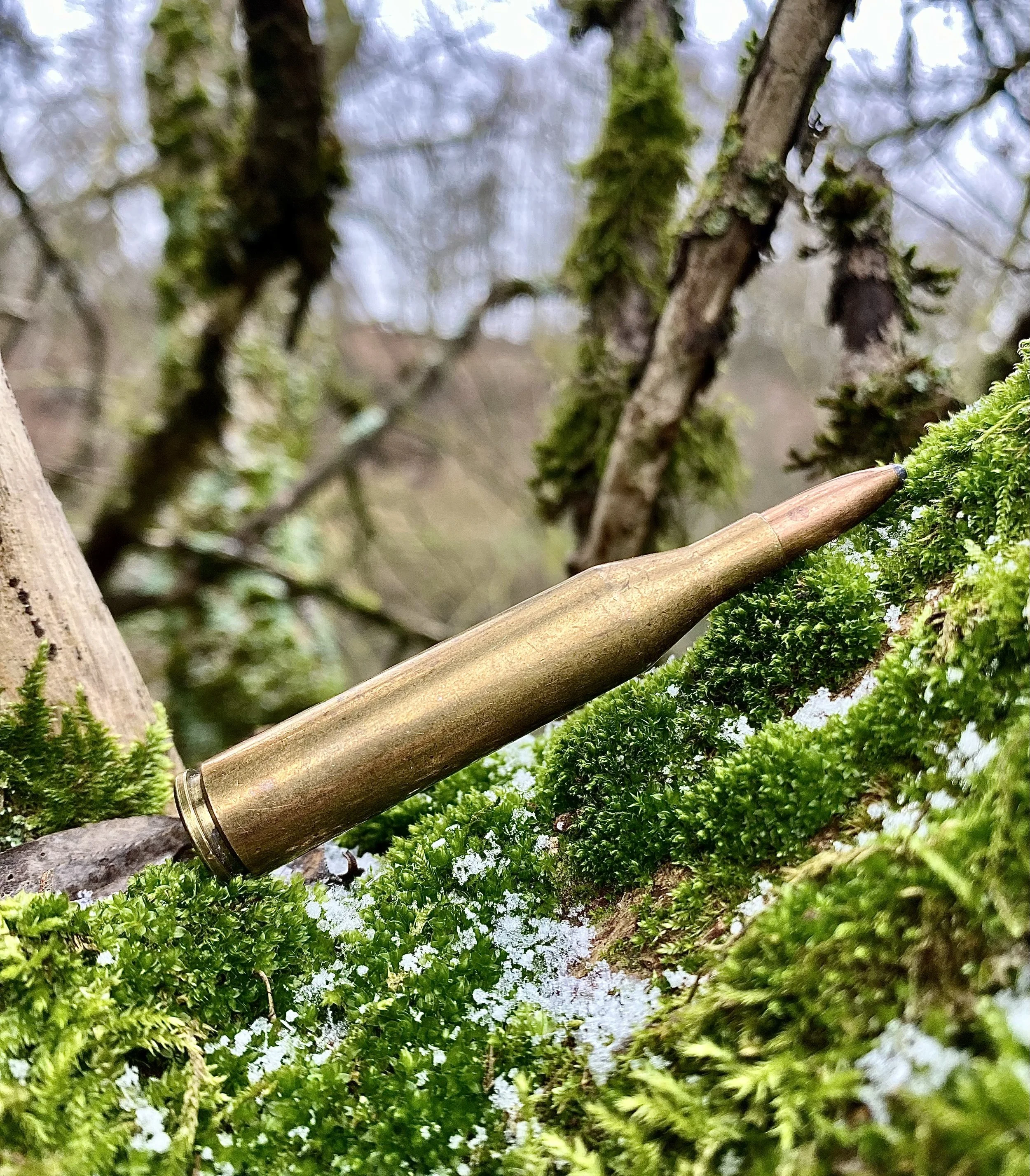Best Binocular for Hunting Elk & Mule Deer
The best binocular for hunting elk and mule deer in the West is not the same as the brightest and most powerful binocular for seeing elk and deer.
12X50 beside smaller 8x42 Tract Toric binoculars illustrate choices in best binocular for hunting elk and mule deer.
Size, weight, magnification, and objective lens size are all things to consider when buying the best binocular for hunting elk and mule deer. These are both
Tract Torics, a 12x50 and an 8x42
.
A Reader's Question
A reader recently asked what binocular I'd recommend for hunting the West:
Hello Ron,
I am a newer hunter looking to hunt out west for elk, mule deer and pronghorn during rifle season. What zoom power do you recommend for a pair of binoculars (10x42 vs 12x50)?
Thanks
Gaurav
Large Swarovski 10x42, mid-sized 8x32, and pocket sized Leica 10x25 binoculars illustrate differences in bulk among best binocular for hunting.
Binoculars come in many shapes and sizes. The brightest or most powerful isn't always the best binocular for hunting. Often you find more game with less power, hunt harder and farther with less fatigue with a smaller unit, and spot more game with less power but more field of view. Swarovski 10x42, 8x32, and
My Best Binocular for Hunting Answer
Guarav, I don't recommend a zoom binocular. Zoom — meaning changing the magnification by dialing a power ring — works well on a rifle scope or spotting scope because there is only one barrel to adjust. With twin barrel binoculars, it is difficult to keep both barrels adjusting to the same power levels.
However, in a single power binocular I recommend either an 8X or 10X. Anything larger is a specialty glass usually at its best when mounted on a tripod or solid surface to minimize vibration. What I've found over 50 years of hunting is that I spot as much game or more with an 8X as anything more powerful, but I can't see significantly more detail with 10X. If I want to judge antlers and horn size, I have to switch to a 20-60X spotting scope and usually crank it up to 40X or so.
The lower magnification binocular has a wider field of view, making it easier to spot game on the fringes. With a tighter view, you could miss a deer or elk slipping through an opening in the brush while you're focused on a spot just out of that field of view.
Mule deer herd running across snowy prairie illustrates how a lower powered binocular with a wide field of view can help find more game.
When hunting you don't need to see fine details so much as locate game in a big, big landscape. A higher power binocular with narrower field of view might not include the big buck at the back of this herd, as the next photo illustrates.
This tighter frame of running mule deer illustrates how a laggind deer can be missed in the narrower field of view of a higher magnification binocular.
This might be what you see with a 10X or 12X as compared to an 8X. Probably not a problem in this case because surely you'd watch the deer run until the buck ran into the view, but were they in an open patch or just going into a draw or if the buck were farther behind, as they often are...
That said, many people prefer the 10X out West. That could work for you unless and until you begin glassing in the forests. There the 10X makes everything too large for easy use. I don't see a huge advantage at 10X in the open, but notice a distinct disadvantage at 10X in the woods.
Ron
Objective Lenses, Power, and Bulk
I don't think I steered Guarav wrong, but I could elaborate and explain the importance of objective lens size. The reason the brightest and most powerful binocular is not the best for hunting the West is bulk and mass. For maximum brightness you need large objective lenses. Those are the big ones out front, the windows that initially admit into the instrument the light reflected off objects. But the bigger these windows, the larger and heavier the binocular. Carrying a five-pound tool the size of a loaf of bread does not make for an easier hunt. But that's not the only stumbling block...
Large 10x50 beside tiny 8x20 binocular illustrates size differences in best binoculars for hunting.
Of course size matters. The bigger Meopta 10x50 will transmit a slightly sharper image simply because the lenses are larger. It's 5mm exit pupil will provide more light if your eye's pupils dilate to 5mm or larger. The tiny Zeiss 8x20 has just a 2.5mm Exit pupil, which can be problematic, as Fine for full daylight, but not low light. On the other hand, if you were climbing 10,000 feet up a mountain goat cliff... There's always a compromise, and it's often right between these extremes.
The more powerful the magnification, the less light that gets out. Power and objective lens diameter always work together. Objective lens diameter doesn't change the power, however. You could have a 4X binocular with 50mm objectives or 20mm objectives and it would still be a 4X.
How can this be? Power or magnification is determined by the curvature of the objective lens, not the diameter. The curve determines the length of the light path as it is bent to its focus point. This is why telephoto photography lenses are so long. The higher the magnification, the longer the lens. But a binocular differs from a photo lens because it has eyepiece lenses that intercept the light from the objective lenses and MAGNIFIES it. Yes, most of the magnification in a binocular results from the focal length of the eyepieces, not the objectives. This is why many manufacturer's 8x42s are the same length as their 10x42s. And why some 10x30s are shorter than some 10x50s. The optical engineers are playing with the ratio of focal length of the objective lens and focal length of the eyepiece lens.
10x42 and 8x42 Swarovski EL binoculars show the same length due to magnification increase coming from the eypiece magnifier.
How can this
be as short as this 8X Swarovski EL roof prism? The magnifying power of the eyepiece lens makes the difference. They could both be the best binocular for hunting depending on the hunter's requirements.
Balance Your Best Binocular for Hunting
The upshot of all this is balance. For hunting you want a balance of size and power. And consensus seems to be that a 40mm to 50mm objective in the 8x to 12X power range is about right. So why not go with 10X or 12X?
You certainly can, but the higher the power, the narrower the field of view and the more the image is compromised by vibration. As you quickly see when you mount a binocular on a tripod, a rock-steady binocular projects a "sharper" image onto your retina. If you wish to carry a tripod and sit and glass for bedded game, the 12X or even 15X are great. But if you're hiking and glassing as you go, less is more.
Backpack hunter crossing rocky stream illustrates why bulky, heavy binoculars are not always the best binocular for hunting..
Backpack hunters in general do not lust after big, heavy binoculars -- at least not while carrying them through terrain like this.
Field of View Critical in Best Hunting Binocular
As for that field of view, this is where the 8X shines. The lower the power, the wider the field of view. Yes, engineers can tweak field of view slightly by shortening eye-relief at any power, but FOV is inherent in magnification. The higher the power, the lower the FOV. The value in a wide FOV is finding game on the fringes. If you are hyper-focused on a tiny part of a mountain at 12X, you aren't going to catch the motion of an elk herd crossing a saddle just outside your view. With the much broader area visible at 8X, you might.
FOV becomes doubly important in the woods. Western hunting isn't always under the big sky. For elk, especially, you're often glassing forested bedding cover. And high magnification can turn a grove of trees into an oversized trunk or two. Less power and more FOV really pay off in the trees. My favorite forest power is 6X. But I can work with 8X. At 10X I'm frustrated. Too much power and detail!
Bull elk in brushy forest cover illustrates need for wide field of view you get with lower magnification.
In woods, forests, and brush, more power equals less success. Most glassing will done at 100 yards or less where field of view becomes even more critical.
When 12X Is Best Binocular for Hunting
I'll admit a 12X or even 15X binocular can be ideal for some kinds of hunting. Coues' deer hunters started this trend. The tactic is to sit at a good overlook and "pick apart" the terrain and habitat spread before you. It's more efficient than hiking and it spooks less game. Of course, you miss half the area that's on the backsides of ridges, down in draws, etc. But during most daylight hours, when game is bedded, a high powered search at 12X or so on a tripod can reveal the secrets you want to discover.
Why not just use your spotting scope for this? You can, but eye strain becomes an issue. The "both eyes open" ease and binocular vision of a binocular make extended searching easier.
12.5X on a Tract binocular illustrates big power.
Tract's Toric 12.5x50mm can be the best binocular for hunting bedded game at long range IF it's mounted rock steady on a tripod or bean bag. High power magnifies hand shakes, wind vibrations and dirty atmosphere as much as target size.
Final Answer
To this veteran hunter, finding game is more critical than seeing it in fine detail. At least initially. Once I locate an animal or herd, I can break out a spotting scope for detailed study if I need it. Or I can simply sneak closer for a better look. And I like to hike, cover ground, see into new basins and valleys. So I appreciate light weight, minimum bulk, great field of view, reasonable power. An 8x42mm binocular provides that. For backpack hunting or a day of serious hiking, an 8x32 will suffice. Even though its exit pupil is just 4mm, with excellent anti-reflection coatings and dielectric mirrors on the phase-coated prisms, an 8x32 is more than bright enough through legal shooting light.
Spomer has hunted with almost as many different binoculars as rifles over his long career.



